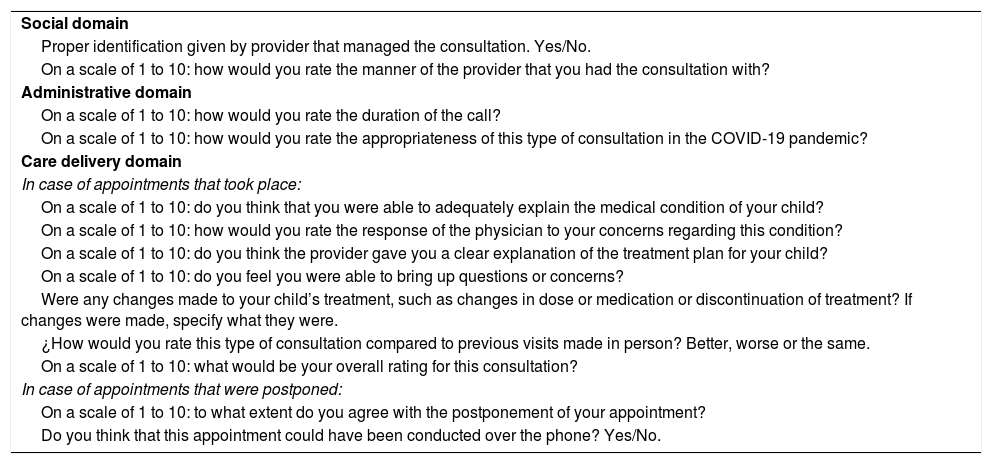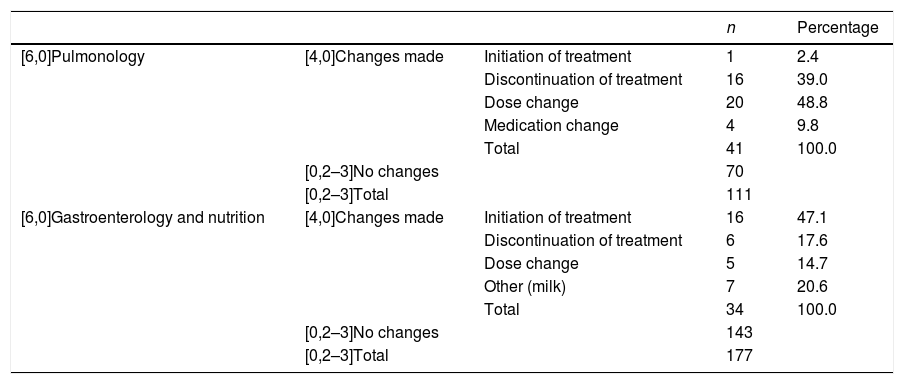The outbreak of infection by a novel coronavirus (SARS-CoV-2) started in early December 2019 in Wuhan (Hubei province, China).1,2 The declaration that the epidemic was a public health emergency of international concern led to the imposition on March 14, 2020 of the state of alert in Spain, with the establishment of population confinement measures and reorganization of work patterns with a shift to remote work. At the hospital level, it was recommended that visits be replaced by telephone consultations. Our aim was to assess the satisfaction with telephone consultations of the families of paediatric patients by means of an anonymous telephone survey.
We conducted a cross-sectional, observational and descriptive study in the department of paediatrics of the Hospital Universitario Central de Asturias (Oviedo, Spain). The study universe consisted of the families of patients that had scheduled follow-up appointments at the outpatient paediatric gastroenterology, nutrition and pulmonology clinics between March 16 (start of telephone consultations in the hospital’s catchment area) and May 11, 2020 (resumption of in-person visits). We assessed the satisfaction of families through a telephone survey, using an anonymous questionnaire that has not been validated after obtaining verbal informed consent. The questionnaire consisted of close-ended questions answered on a scale from 1 to 10 (1 indicating minimum degree, 10 maximum degree) and binary questions (yes/no) (Table 1). The study was approved by the ethics committee of the Principality of Asturias (Ref. 2020.204). Researchers did not receive any remuneration for the study.
Survey questionnaire.
| Social domain |
| Proper identification given by provider that managed the consultation. Yes/No. |
| On a scale of 1 to 10: how would you rate the manner of the provider that you had the consultation with? |
| Administrative domain |
| On a scale of 1 to 10: how would you rate the duration of the call? |
| On a scale of 1 to 10: how would you rate the appropriateness of this type of consultation in the COVID-19 pandemic? |
| Care delivery domain |
| In case of appointments that took place: |
| On a scale of 1 to 10: do you think that you were able to adequately explain the medical condition of your child? |
| On a scale of 1 to 10: how would you rate the response of the physician to your concerns regarding this condition? |
| On a scale of 1 to 10: do you think the provider gave you a clear explanation of the treatment plan for your child? |
| On a scale of 1 to 10: do you feel you were able to bring up questions or concerns? |
| Were any changes made to your child’s treatment, such as changes in dose or medication or discontinuation of treatment? If changes were made, specify what they were. |
| ¿How would you rate this type of consultation compared to previous visits made in person? Better, worse or the same. |
| On a scale of 1 to 10: what would be your overall rating for this consultation? |
| In case of appointments that were postponed: |
| On a scale of 1 to 10: to what extent do you agree with the postponement of your appointment? |
| Do you think that this appointment could have been conducted over the phone? Yes/No. |
Of the 515 scheduled visits, 408 were conducted by telephone. After excluding candidates that did not answer the phone, those that refused to participate and those that had scheduled their first visit, we obtained a final sample of 288 phone survey participants (distribution by speciality: gastroenterology, 157; pulmonology, 11; nutrition, 20). The mean age of the adult in charge of the patient was 41.72 years (standard deviation [SD], 6.8; range, 24–73), and mothers were the most frequent respondents (86.4%). All assessed aspects received ratings with a mean above 9 points, and the overall rating of the phone consultations was 9.61 points (SD, 0.82; range, 4–10). We did not find significant differences in the ratings given to the different speciality clinics or based on the different diseases managed in each speciality.
Of all respondents, 57.3% thought that telephone consultations were better or as good as in-person visits and 42.7% that they were worse. The mean age of parents that thought telephone consultations were worse (42.86 ± 6.12 years) was 2 years older compared to parents that thought they were better or as good as in-person visits (40.87 ± 7.19) (P = .014). The logistic regression analysis adjusted for the medical speciality found that the probability of preferring in-person visits increased with increasing respondent age (OR = 1.048; 95% confidence interval, 1.011–1.086).
Changes to treatment were made in 75 consultations. These changes were more frequent in pulmonology consultations compared to gastroenterology and nutrition (36% vs 19.8%; P = .02), and dose adjustments were the most frequent type of change, amounting to 48.8% of the total. However, in the gastroenterology and nutrition clinics, the most frequent change was initiation of a new treatment, which amounted to 47.1% of treatment changes (Table 2). Changes in treatment were not associated with changes in the overall rating of telephone consultations (same or better than in-person visits rating: 57.8% in the group with changes compared to 56.8% in the group without changes; P = .780).
Changes in treatment by medical speciality.
| n | Percentage | |||
|---|---|---|---|---|
| [6,0]Pulmonology | [4,0]Changes made | Initiation of treatment | 1 | 2.4 |
| Discontinuation of treatment | 16 | 39.0 | ||
| Dose change | 20 | 48.8 | ||
| Medication change | 4 | 9.8 | ||
| Total | 41 | 100.0 | ||
| [0,2–3]No changes | 70 | |||
| [0,2–3]Total | 111 | |||
| [6,0]Gastroenterology and nutrition | [4,0]Changes made | Initiation of treatment | 16 | 47.1 |
| Discontinuation of treatment | 6 | 17.6 | ||
| Dose change | 5 | 14.7 | ||
| Other (milk) | 7 | 20.6 | ||
| Total | 34 | 100.0 | ||
| [0,2–3]No changes | 143 | |||
| [0,2–3]Total | 177 | |||
Chief among the limitations of the study is its small sample size, which precludes extrapolation of efficacy outcomes. Participants were recruited by consecutive sampling in outpatient clinics, so the results cannot be generalised to patients with acute disease or patients having their initial appointment with the clinic. In addition, the questionnaire was developed by the authors and was not validated or based on other previously validated instruments.
The need to avoid crowding and to minimise contact between individuals and the fear of contagion have promoted an exponential growth in telemedicine services from the start of the pandemic. In the field of paediatrics, systematic reviews addressing SARS-CoV-2 have been published, but few studies have assessed the level of satisfaction in relation to this shift in health care delivery.3,4 A gradual adaptation of the population to this change in practices and satisfaction surveys at regular intervals are essential to identify opportunities for improvement in this approach to health care, so that in future telemedicine can supplement or offer an alternative to traditional medical visits. In conclusion, while families gave very positive ratings to the different items in the telephone survey, this type of remote consultation is still not widely accepted compared to in-person visits.
Please cite this article as: Navarro Campo S, Díaz García P, Quesada Colloto P, Gutiérrez Martínez JR, Díaz Martín JJ. Satisfacción de las consultas telefónicas realizadas durante el confinamiento por COVID-19. An Pediatr (Barc). 2021;95:482–484.





